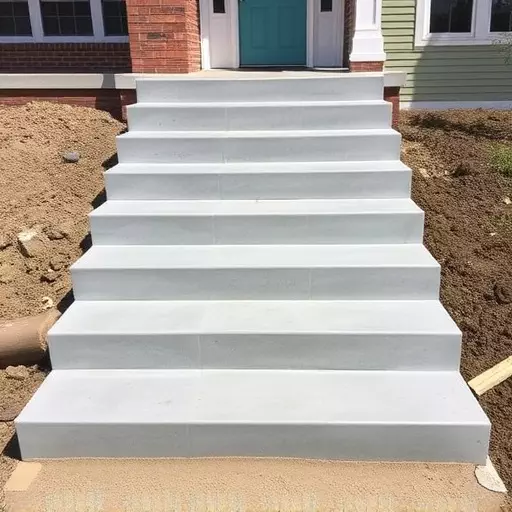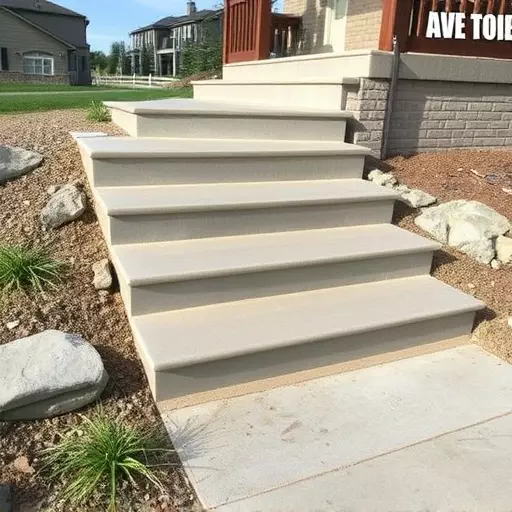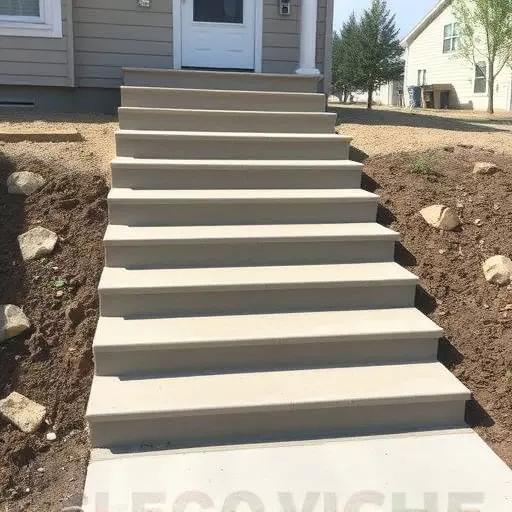The concrete step construction process in Toledo is meticulous, catering to both residential and commercial properties. It begins with thorough groundwork preparation, form setup, and strategic rebar placement for structural support. Pouring fresh concrete creates durable steps that meet aesthetic and functional standards. This process ensures safety, longevity, and versatility for various traffic levels and weather conditions. Aesthetics are key in residential designs, incorporating customizable finishes, colors, and textures. Commercial projects demand larger scales, complex designs, and precise planning for higher foot traffic. Successful construction requires specific materials, tools, and multi-step processes, including form preparation, concrete mixing, reinforcement, and final coatings. Regular maintenance is crucial to preserve the longevity of both residential and commercial concrete steps in Toledo.
Residential concrete steps are not just functional elements but can also enhance a property’s curb appeal. This comprehensive guide delves into all aspects of concrete step construction, from understanding the basic overview and materials used to design considerations for aesthetic appeal. We explore both residential and commercial concrete step construction processes, offering a step-by-step installation guide and best practices. Additionally, maintenance tips ensure longevity for these durable structures, with a focus on techniques relevant to the Toledo area.
- Understanding Residential Concrete Steps: A Basic Overview
- The Role of Concrete in Step Construction
- Design Considerations for Aesthetic Appeal
- Materials and Tools Required for the Job
- Step-by-Step Guide to Concrete Step Installation
- Best Practices for Commercial Concrete Step Construction
- Maintenance and Longevity Tips for Concrete Steps
Understanding Residential Concrete Steps: A Basic Overview

Concrete steps are a fundamental element in many residential and commercial structures, offering both functionality and aesthetic appeal. Understanding their construction process is essential for anyone considering installing or repairing them. The basic structure involves several key components: the foundation, the step forms, rebar reinforcement, and finally, the concrete pour.
In Toledo and beyond, the typical concrete step construction process begins with preparing the groundwork. This includes excavating and leveling the site to ensure a solid base. Step forms are then placed to create the desired shape and height of each step. Rebar is strategically positioned within these forms to enhance structural integrity, especially in commercial concrete step construction projects that bear heavier loads. Once the rebar is in place, fresh concrete is poured, filling the forms and bonding with the reinforcement to create a robust and durable step surface.
The Role of Concrete in Step Construction

Concrete plays a pivotal role in the construction of both residential and commercial steps. The durable and versatile material forms the structural backbone, ensuring safety and longevity. The concrete step construction process in Toledo involves several precise stages: first, the preparation of the substrate, followed by setting up forms to define the shape and size of each step. Then, skilled workers pour the concrete, vibrate it to eliminate air bubbles, and allow it to cure over time. This meticulous process results in robust steps that can withstand heavy foot traffic, extreme weather conditions, and the test of time, making concrete a superior choice for any outdoor staircase.
In residential settings, concrete steps offer aesthetic appeal and functional benefits, enhancing curb appeal and providing easy access to homes. Commercial concrete step construction requires similar attention to detail but often involves larger scales and more complex designs to cater to higher foot traffic and varied architectural styles. Regardless of the context, the use of concrete guarantees a robust structure that can be customized with various finishes, colors, and textures to complement different architectural themes.
Design Considerations for Aesthetic Appeal

When designing residential concrete steps in Toledo or any other area, aesthetics play a significant role in enhancing the curb appeal and overall look of a property. The concrete step construction process involves more than just structural integrity; it’s about creating visually appealing features that complement surrounding architecture and landscapes. Homeowners and designers should consider material finishes like smooth, brushed, or exposed aggregate to add texture and visual interest. Color choices can also transform steps from mundane to stunning, with options ranging from neutral tones to vibrant hues.
Furthermore, the integration of decorative elements such as custom-molded caps, LED lighting, or handrails with intricate designs can elevate the aesthetic appeal. Balancing functionality with design is key; ensuring the steps are not only visually pleasing but also safe and accessible for residents and visitors. This attention to detail in both structure and aesthetics ensures that residential concrete steps not only serve their practical purpose but also become a distinctive part of a property’s identity, rivaling even those seen in commercial concrete step construction projects.
Materials and Tools Required for the Job

When embarking on a residential concrete steps project in Toledo, whether it’s a new construction or renovation, several essential materials and tools are required to ensure a robust and durable outcome. The foundation of any concrete step is the materials used—from the concrete mix itself to reinforcing bars (rebar) for structural integrity. In addition to these, trowels, shovels, and wheelbarrows facilitate mixing and transporting the concrete. For finishing touches, tools like brooms, wire brushes, and water hoses are needed to clean up the work area.
In terms of commercial concrete step construction, similar materials and tools are employed but often on a larger scale. The process remains the same, beginning with site preparation and ending with curing and safety treatments. Whether for residential or commercial projects in Toledo, understanding the materials and tools necessary is a crucial first step in the concrete step construction process, ensuring a strong and aesthetically pleasing final product.
Step-by-Step Guide to Concrete Step Installation

Installing concrete steps is a multi-step process that requires careful planning and execution. First, assess your project’s needs and ensure proper preparation by clearing the area and checking for level ground. Next, create a detailed plan including measurements and designs, which will guide the entire construction process.
The actual construction involves preparing forms, mixing concrete, and pouring it into the forms. Reinforcement with steel bars is crucial for strength and stability. After the concrete sets, remove the forms, cut the steps to the desired height and shape, and finish by applying appropriate coatings or textures to enhance durability and aesthetics. This meticulous approach ensures both functional and visually appealing residential or commercial concrete step construction in Toledo.
Best Practices for Commercial Concrete Step Construction

When constructing commercial concrete steps in Toledo or any other location, adhering to best practices is essential for durability and safety. The process begins with meticulous planning and design, ensuring the steps cater to the specific needs and traffic patterns of the site. Proper drainage is a key consideration; slope and grade must be calculated to prevent water accumulation, which can lead to structural damage over time.
Using high-quality materials is paramount for commercial concrete step construction. Reinforcement with steel bars or mesh should be placed at strategic intervals to enhance strength and bear heavy loads. The concrete mix itself should be carefully formulated, balancing compressive strength and workability to ensure a robust finished product. Regular inspections during construction are vital to catch any defects early, ensuring the final steps meet safety standards and aesthetic expectations.
Maintenance and Longevity Tips for Concrete Steps

To ensure your residential concrete steps stand the test of time, regular maintenance is key. Start with a simple cleaning routine using mild detergent and a soft brush to remove dirt and stains. Avoid harsh chemicals that can damage the surface. Seal the steps annually with a high-quality concrete sealer to protect against moisture, salt, and UV rays, all of which can contribute to structural deterioration. This protective layer also helps prevent stains from becoming permanent.
For longer-lasting concrete steps, consider the construction process. In Toledo, both residential and commercial concrete step projects benefit from proper formwork, rebar placement, and a high-quality concrete mix. Skilled contractors understand the importance of these elements in creating durable steps that can withstand heavy foot traffic without cracking or breaking. Regular inspection for signs of damage or wear and immediate repair will further contribute to their longevity.


